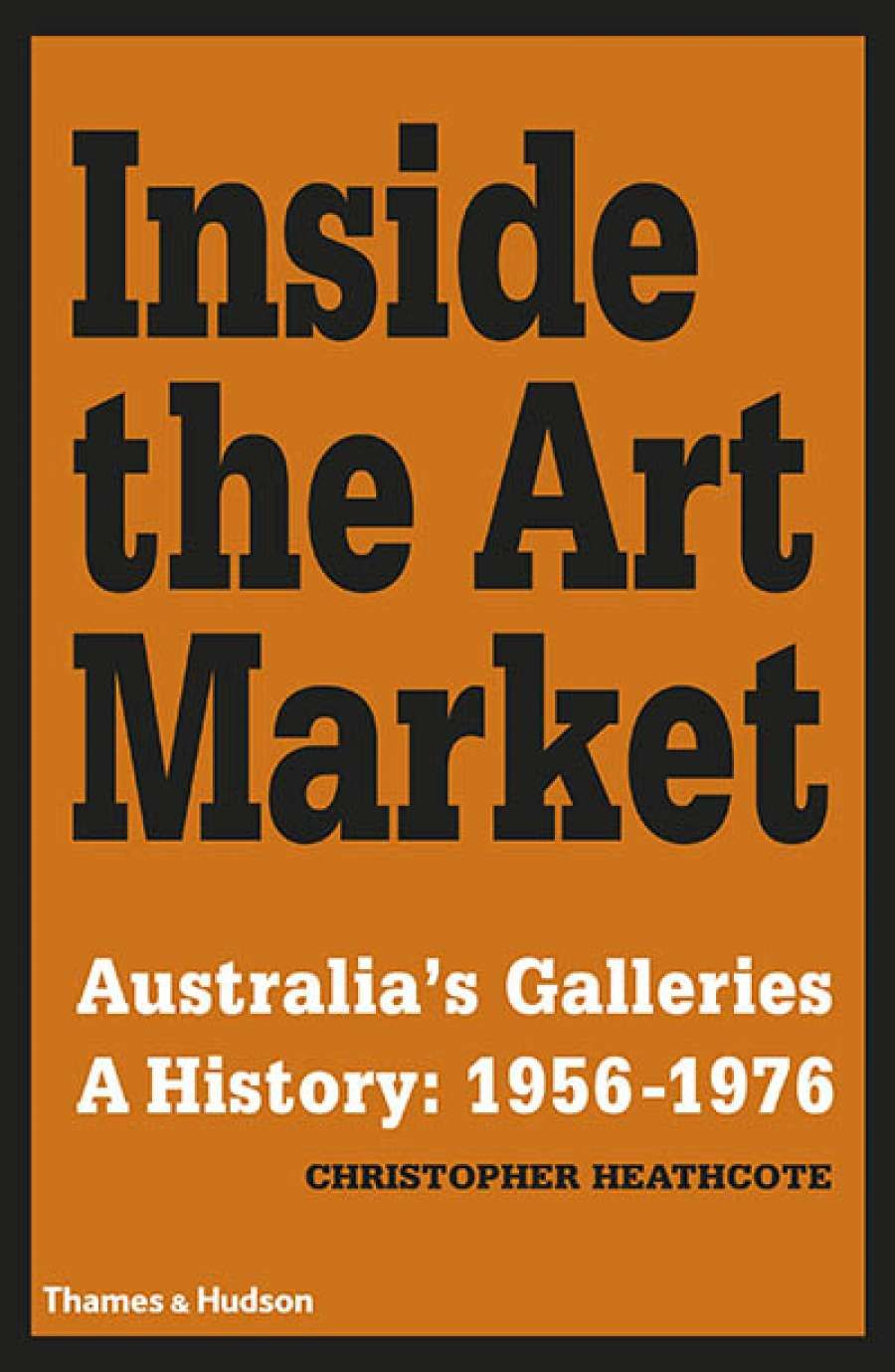
- Free Article: No
- Contents Category: Art
- Custom Article Title: Francesca Sasnaitis reviews 'Inside the Art Market: Australia’s galleries: A history 1956–1976' by Christopher Heathcote
- Custom Highlight Text:
Like any good storyteller, Christopher Heathcote begins by setting the scene: ‘one of those scruffy unpaved streets on the outer fringe’ of Melbourne on a wintry day in 1956 ...
- Book 1 Title: Inside the Art Market
- Book 1 Subtitle: Australia’s galleries: A history 1956–1976
- Book 1 Biblio: Thames & Hudson $49.99 hb, 368 pp, 9780500500705
There were galleries operating before the Purveses opened their doors on Derby Street in Collingwood, once an inauspicious working-class neighbourhood, but most were attached to other businesses – antiques, furniture, bookshops, restaurants – and catered to conservative and conformist tastes. What the Purveses brought to the Melbourne scene was an enthusiasm for the ‘new’ expressionist painters and an unprecedented professionalism. Their innovative, some would say ruinous, business model included not charging their artists rent; selling work on commission; maintaining a permanent stable and stockroom, strict accounts, and provenance records; and offering certain artists modest stipends, paying for their materials and framing, and inviting them to stay at their house on the Mornington Peninsula. Naturally, their largesse was not merely altruistic but part of an astute marketing strategy.
Other galleries followed suit, but the return on investments was far from guaranteed. Shows by Arthur Boyd, John Perceval, Sidney Nolan, Albert Tucker, and their coterie did well, but others like John Brack, Fred Williams, and Ian Fairweather were not so successful initially. The enthusiasm of art dealers might not have swayed public taste or re-educated the public eye but for the support of art critics like the Melbourne Age’s Patrick McCaughey, Herald columnist Alan McCulloch, and ‘the perky young writer Robert Hughes’ from Sydney, subjects for another history perhaps.
Following the mining boom of the 1950s, Australia became an aspirational nation. According to Bernard Smith, art became a means towards national self-identification. Collecting art was akin to acquiring status and a mark of superior taste. By the mid-1960s, ‘those who took an interest in art were perceived as intelligent, forward-thinking and enlightened members of the community’, and Australians’ reputation for insularity (and vulgarity) had been somewhat eroded. It is hardly surprising that the evolution of the domestic art market should parallel the economic and cultural development of Australian society.
Heathcote writes from his experience as a newspaper art critic and an aficionado of the gallery milieu, and his account is peppered with juicy descriptions of flamboyant characters, spectacular openings, fabulous frocks, and polka-dotted ties; art scene gossip and carping; exhibitions that created a furore; bidding wars and auction houses that played their part in inflating the value of Australian art; and conversations to which Heathcote could not have been privy but which he endows with a sense of immediacy.
 Portrait of Anne Purves by Brian Dunlop, oil on canvas, 1991 (National Gallery of Victoria)
Portrait of Anne Purves by Brian Dunlop, oil on canvas, 1991 (National Gallery of Victoria)
It is as if Heathcote were the proverbial fly on the wall at every significant moment in this twenty-year history, a testament to the scope of his research, the many interviews he conducted as far back as 1988, and the degree of trust his long association with the arts has engendered in the artists, gallerists (the latest term), writers, and collectors. Most importantly in a volume starkly lacking reproductions, apart from the handsome author portrait by photographer Sonia Payes, Heathcote brings the vibrancy and dynamism of the originals to his description of traditional paintings, to the innovations and idiosyncrasies of modernism, and to revolutionary conceptual and installation art.
If I have any quibbles, it is not with Heathcote but with history. Women’s names are scarce. Heathcote has been assiduous in mentioning female artists, but women generally fare better as facilitators (proprietors and dealers) than as makers. He touches only briefly on the exclusionary boys’ club atmosphere of the mid-twentieth century, and the changes wrought by feminism and an awareness of sexual politics. My interest waned as the colourful individuals of the previous decades made way for the bureaucrats of the 1970s, the number of galleries trebled, and the government stepped up with increased grants and prizes. What must have been a windfall for artists does not necessarily make for scintillating narrative. Nor can the subsequent economic recession match the urgency and anxieties of the halcyon days.
All that remains is a slow drift into the 1980s and its new breed of gallerist, more canny but also more arrogant and self-congratulatory. It is a dispiriting note on which to end. Heathcote has certainly fulfilled his aim to ‘dispel illusions’ about art dealing with this dynamic account of a compelling period in Australian art history.


Comments powered by CComment